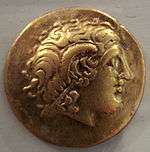Namnetes
The Namnetes were a tribe of ancient Gaul, living in the area of the modern city of Nantes[1] near the river Liger (modern Loire).

They were neighbours to the Veneti people (north-west), the Redones (North), the Andecavi (east) and the Pictones (south).
In the spring 56 BC during the Gallic wars and according to Caesar, the Namnetes allied to the Veneti to fight against the fleet made by Caesar.[2] Decimus Brutus, leader of the Roman fleet, finally won the battle.[3]
During Roman domination, the Namnete capital city was located at the confluence of the Loire and the Erdre; its name was probably Condevicnum.[4] During the 3rd century AD, the city became known as Portus Namnetum,[5] then Nantes in the Middle Ages.
Name
They are mentioned as Namnitō͂n (Ναμνιτῶν) by Polybius (2nd c. BC) and Strabo (early 1st c. AD),[6][7] as Namnetes by Caesar (mid-1st c. BC) and Pliny (1st c. AD),[8][9] and as Namnē͂tai (Ναμνῆται) by Ptolemy (2nd c. AD).[10][11]
Samnitae/Namnete Women's Island
According to Strabo, quoting Poseidonios, there is an island in the Ocean near the outlet of the Loire river which was inhabited by the "women of the Samnitae," which is generally taken to be a mistake and actually refers to the "Namnitae" or Namnetes.[12] No man was ever allowed on the island and the women themselves sailed from it to have intercourse with men on the continent before returning there again. They also had the strange custom of unroofing their temple every year and roofing it again on the same day before sunset, each woman bringing her load to add to the roof. The woman whose load would fall out of her arms was rent to pieces by the rest, and they allegedly carried the pieces round the temple with the cry of "Ev-ah" in a frenetic manner.[13]
According to French archaeologist Jean-Louis Brunaux, there are three reasons to consider the story as factual. First, the wet and windy climate of Western Gaul suggest that the Gallic dwellings (made of branches or reed) were re-roofed every year. Second, not to drop new material was, according to Pliny the Elder, a common religious practice of the Celts. Third, circumambulation existed as a rite among the Celts according to Poseidonios.[14]
References
- A compendium of ancient and modern geography by Aaron Arrowsmith p. 148
- Julius Caesar, III, 9
- Julius Caesar, III, 14
- The name Condevicnum is first quoted in Greek ("Kondeouiknon") by Ptolemy, but the identification Condevicnum=Nantes is not absolutely certain. The latitude and longitude given by Ptolemy for Condevicnum are quite wrong for Nantes.
- Portus Namnetum is quoted in Peutinger's Table : "portunamnetu".
- Polybius. Historíai, 34:10:6
- Strabo. Geōgraphiká, 4:2:1
- Caesar. Commentarii de Bello Gallico, 3:9:10
- Pliny. Naturalis Historia, 4:107
- Ptolemy. Geōgraphikḕ Hyphḗgēsis, 2:8:8
- Falileyev 2010, p. entry 3280.
- The dichotomy Samnitoi-Namnitoi is also present in Ptolemy's Geography : he writes that the Namnitoi live "south of the Veneti" while the "Namnitoi" are far in the east of the Andecavi and the Cenomani.
- Strabo, Geography, IV, 4, 6
- Jean-Louis Brunaux. Les Druides. Des philosophes chez les barbares. Paris, Seuil, 2006, p. 241
Bibliography
- Falileyev, Alexander (2010). Dictionary of Continental Celtic Place-names: A Celtic Companion to the Barrington Atlas of the Greek and Roman World. CMCS. ISBN 978-0955718236.

